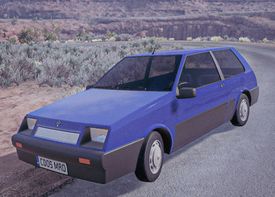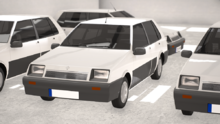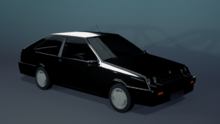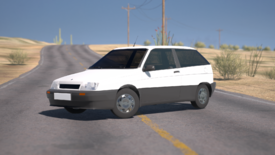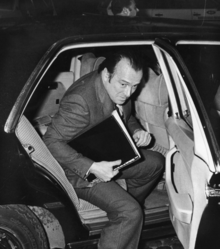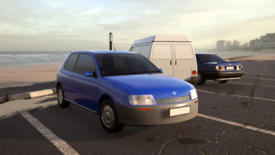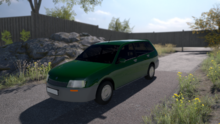Azavedo 8
| Azavedo 8 | |
|---|---|
A first generation Azavedo 8 C. | |
| Overview | |
| Manufacturer | Azavedo Empresa Automobilistica |
| Production | 1973–present |
| Assembly | |
| Designer | Samuel Pinho |
| Body and chassis | |
| Class | Super budget compact car |
| Body style |
|
| Layout |
|
The Azavedo 8[note 1] is a series of hatchback, super budget cars manufactured and marketed by the Andaluzian automaker Azavedo Empresa Automobilistica. The series was initially a failure within its home country of Andaluzia, however, it prospered and sold tens of thousands of cars within Creeperopolis, as the common low to lower-middle class of the country found the car series to be extremely economical. The series' cheap price and excellent gas mileage (19.2 mpg highway, 17 mpg city) with its 800cc Nadadeira engine helped it gain popularity in the Creeperian car market, eventually outcompeting the Zaldívar Esperanza in sales.
Since the series' introduction, it has become the most widespread car series driven in Creeperopolis. The series was so widely popular that in 1975, the Creeperian government began to issue registration plates with the starting designator of "A" instead of the common "P", making Creeperian Azavedo 8s with a "P" registration plate extremely rare. Additionally, the Azavedo 8 has frequently been incorrectly referred to as a Creeperian car series, rather than an Andaluzian one.
Contents
First generation (1973–1984)
| First generation | |
|---|---|
| Overview | |
| Production | 1973–1984 |
| Assembly | |
| Body and chassis | |
| Body style | 3/5-door hatchback |
| Layout |
|
| Powertrain | |
| Engine | 800cc Nadadeira |
| Transmission | 4/5 gear manual |
| Dimensions | |
| Wheelbase | 90.55 inches |
| Length | 147.28 inches |
| Width | 60.31 inches |
| Height | 50 inches |
| Curb weight | 1524 lbs |
8 C
The 8 C is the standard model of the Azavedo 8 series. It has three doors with two seats in the front and a bench in the back. The engine was the 800cc Nadadeira (Jackian: Paddle) which produced 39 horsepower and 37.5 lb-ft of torque. The gearing was manual, and was limited at 90 mph, however the chance of an Azavedo 8 seeing that speed was rare. Since it's inception, it was very popular with the younger crowd, due to its perceived increased sportiness due to the fact it was a three door, versus the 8 CR's five door construction. The car came in a variety (three) of colors, being Azavedo Blue, white, and black. The car, when released, was the only version of the car available, due to it being the first of it's kind. In its home country of Andaluzia, the car sold very poorly due to the perception of it being a waste of money. The people of Andaluzia would rather pay an increased price for luxuries such as standard rolling windows, air-conditioning, and a full size frame. Many critics of the car also claimed it was simply too slow, creating problems when attempting to enter and maintain speed on the highly developed Andaluzian road system.
Selling in Creeperopolis
After seeing the abysmal performance of the car within Andaluzia, the now infamous director of sales, Sérgio Silvestre, took the chance to sell the 8 C within the country of Creeperopolis. At the time, many thought of this idea as pointless, as the mere shipping cost would almost remove any profit margins, causing each car to be a loss, however, in a stroke of luck, the car was an instant success. The main features that the Creeperans liked were very low price (₵1,500 ₰1,800 ₡12,000), and rugged suspension in the car which assisted it in moving around the underdeveloped sections of Creeperopolis. This resurgence of sales caught Azavedo by surprise, as they ran out of nearly every car built within Andaluzia within four months, causing the creation of the Azavedo Waitlist and leading to the development of Azavedo Manufacturing Santiago Tex. Until the plant was complete, Azavedo struck a deal which lead to them renting an unused Zaldívar Vehicle Company facility in Quetgoza from August 1974 until April 1976, when the Azavedo plant was complete.
The widespread sales of the 8 C overwhelmed vehicle registration plates issuance facilities. By 1975, the Ministry of Transportation began issuing the starting designator "A" for specifically Azavedo 8s, replacing the starting designator "P" which was used by all civilian and personal vehicles. From 1975, all Azavedo 8s used the starting designator of "A" in all Creeperian departments, which as a result, made Azavedo 8s with a "P" registration very rare and highly collectable.
8 CR
After Silvestre saw the success of the 8 C within Creeperopolis, and receiving feedback from the community of 8 C owners, a next step was clear to him. In June 1976, the Azavedo 8 CR was created, bolstering a set of rear doors, meaning the total amount of doors increased to five, and a slightly higher ride height so it was easier to climb over difficult terrain. The car was powered by the same Nadederira motor as in the 8 C with no modification to keep costs low. The car also added the additional option of a welded hooks which attached to the frame of the car on the front and back to avoid damaging the car if it every was stuck in mud and needed to be pulled out. This car was available in the same colors as the standard 8 C, which was Andaluzian Blue, white, and black.
The 8 CR model saw great success, succeeding the original 8 C within Creeperopolis, especially in its more rural areas where the roads and trails were less maintained. The car model has since become one of the most common Creeperian cars, eventually outcompeting various Creeperian-made cars such as the Zaldívar Esperanza. The "CR" of 8 CR has sometimes been erroneously referenced as meaning "Creeperian" when it actually means "rear doors."
8 CT
The success, both financially for Azavedo, and job-security wise for Silvestre, was tremendous. By 1977, the company sold over 300,000 Azavedo 8s. At this time, Silvestre moved to Creeperopolis to the town of Santiago Texacuangos to directly monitor the factory from his newly appointed position of the Azavedo Creeperopolis division lead. Once in Creeperopolis, it was suspected by the general public at the time that Silvestre began to be influenced by local gangs and crime organizations, but no accusations ever came to fruition. One of the reasons for this accusation was the creation of the 8 CT. It was a turbo charged performance version of the 8 C, with a new body. The base engine was still the 800cc Nadederia motor, however, it went under extensive upgrades including forged internals, turbo charging, modified exhaust system, and a new intake system. This model made just over 61 horsepower with 48 lb-ft of torque versus the 8 Cs 39hp. Many at the time saw this as being made specifically for the gangs of Creeperopolis as the every day person had no need for such a car as it used more expensive fuel, however it was found to get slightly better gas mileage with 19.7 mpg highway and 17.5 mpg city.
The main change other than the increased horsepower, was the change to rear wheel drive. This caused the car to be much faster around the corners, which led to the use of the car in the 1977 Pan-Creeperian Coronation Rally. Their relative success for the low horsepower caused the car to see increased sales within Creeperopolis. The body style was changed considerably as well. The roof was no longer extended to the back, with it instead being sloped much earlier. It also had new headlights which provided a more "sporty" look. The car also features an extra gear, increasing the total amount of gears to five.
8 CRTT
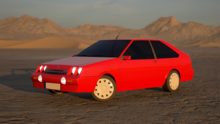
The 8 CRTT is an extremely rare version of the Azavedo 8 that was made on the 8 CT platform for the use of the Azavedo Motorsport team in the 1978 Pan-Creeperian Rally. The car featured an entirely new engine, suspension system, interior, and gearbox. This all made the car much more expensive, and essentially unobtainable for the average person in creeperopolis. Due to this, the car saw a limited production run.
The car was relatively fast, with an inline five-cylinder engine producing 177 horsepower and 187 lb-ft of torque. The engine had a single overhead cam with three valves, with forged internals along with a turbocharger that pushed out 14.5 psi at maximum boost. The car is also the first Azavedo 8 that featured electronic fuel injection, however at the time it was only single point. The suspension was hydropneumatic, a new form spring for the time, along with twin-tube dampers.
Second generation (1985–1994)
| Second generation | |
|---|---|
An Azavedo 8 2C in 1985. | |
| Overview | |
| Production | 1985–1991 |
| Assembly | |
| Body and chassis | |
| Body style | |
| Layout |
|
| Powertrain | |
| Engine | 1.4 liter Valejar |
| Transmission | 5 gear manual |
| Dimensions | |
| Wheelbase | 99.61 inches |
| Length | 163.55 inches |
| Width | 69.12 inches |
| Height | 54 inches |
| Curb weight | 2063 lbs |
8 2C
The Azavedo 8 2C is the successor the the ever popular Azavedo 8 C. It saw a complete re-design of both the chassis and engine. The main complaints of the first generation were the lack of space for "luggage" in the car, so the most noticable change was the large widening, and lengthening of the car. This also saw the car gain 510 lbs which in-turn brought about the new Valejar (Jackian: Sail). The new engine featured a direct acting overhead cam, along with 22.5 extra horsepower.
The car also featured five forward gears as standard, which made it easier to accelerate to highway speeds, another major complaint. Although it was more powerful, the engine in fact saw an increase in fuel efficiency (21 mpg highway, 18 mpg city), contributing to one of many factors that many news outlets and car magazines, such as Carros Hoje, deemed the 8 2C a "complete and fulfilling upgrade."
8 2CR
When Azavedo first sold the original 8 CR in Creeperopolis, many critics, including the Llantas Negras automotive magazine, claimed that the addition of the rear door was a "cheap copout" due to the small size of the doors, and no increase to cargo capacity. The claims were heard by Azavedo because in 1984 when the Azavedo 8 CR was announced and showed for the first time, preorders were taken for the car. The inclusion of preorders created the first known case of "preorder skipping" where people would buy someone else's preorder to increase their position in line.
8 2CT
The Azavedo 8 2CT is a upgraded sport model of the Azavedo, boasting 107 horsepower and 110 lb-ft of torque. It does this by including forged internals, and a turbo charger. The turbo charger uses the new twin scroll design, which allowed for the boost to come in earlier. It also includes a new version of boost control which means that boost can be increased as it is limited more efficiently. The new car featured a sporty new look, including a full trunk and the inclusion of the new color choice of gray, increasing the total color choices to four.
8 2CRTT
The Azavedo 8 2CRTT was the second generation of the rally homologation version of the Azavedo 8. It was built on the chassis of the Azavedo 8 2CT, with a further upgraded version of its inline five motor. It now sports up to 230 horsepower with increased torque aswell. The car was built in the Andaluzian plant in Bicada, and was built to the number of 20,400 cars. This success was due mainly to sales numbers shown from the first generation car, as almost every car was sold as it was produced. The second generation didn't do as well on the track, however; it only saw partial success on the track, with only a handful of wins around Andaluzia in the Campeonato de Rali da Andaluzia. This is believed to be why the racing division at Azavedo recieved nearly triple the budget it did in 1990, as it did in 1980.
8 2A
The Azavedo 8 2A was made to be the luxury, high end model of the Azavedo 8. The car was built at the Bicada plant in Andaluzia, along with all other special models of the 8. The interior was made with high quality Andaluzian madeira clara, a wood special to the Bicada region. The upholstery was a custom made cloth interior, and the front seat was capable of rotating around to face the back two seats. The car sold well among lower level politicians and wealthier businessmen in Creeperopolis. The car was known for it's very comfortable interior and smooth ride, however the car was mildly underpowered as it used a tuned version of the Valejar engine.
Controversies
La'Unión piracy and production delay

On 29 November 1984, the MN Paraíso del Río, a car transport ship carrying 835 newly produced Azavedo 8 2Cs, was raided by armed gunmen of the Creeperian Mafia. The 835 Azavedo 8 2Cs, which were due to be delivered to San Salvador to be used in promotional displays, car magazines, and car review sites, were stolen to be sold by Mara Salvatrucha at extorted prices prior to their official release and, although not known at the time, to steal packets of cocaine which were hidden within cavities in the cars. This event ended up leading to the delay of the release of car by one month and cost Azavedo hundreds of thousands of escudos. The ship itself has not been found since and is widely believed to be wrecked at the bottom of Lake San Salvador. Only around 300 cars were recovered by the Creeperian government, with the fates of the remaining 500 cars being a mystery.
Controversial advertisements
The Chatarra advertisement was both the most successful and worst performing car advertisement in the history of Azavedo. The advertisement brought about waves of negative media and heavy criticism from sources such as the Gaceta Creeperiano, Llantas Negras, and Tiempos de La'Unión, while also providing essentially free publication of the advert by those same people. All of the attention against the advertisement was due to the use of the wrong form of Spanish in the advertisement.
The creator of the advertisement, Flávio Saraiva, was an Andaluzian, and as a result, he wrote the advertisement in the Andaluzian form of Spanish instead. Everyone in Azavedo's marketing department were also Andaluzians, and none of them spoke Creeperian either. With the fact that none of the previous adverts prior were incorrect simply due to coincidence, no one decided to double check to make sure the advertisement was in fact correct.
Instead of reading "¿Tienes basura para'su tronca?" (Do you have junk for your trunk?), it read "¿Tienes chatarra para'su baúl?" which was incorrect. Although the "para'su" was rendered correctly, as Azavedo had previously been criticized for using the incorrect "para tu" instead, neither "chatarra" nor "baúl" were words in Creeperian and many were confused by the advert.
The advertisement still has an impact in modern Creeperian culture, as many Creeperian jokingly call Andaluzians "chatarras" and the advertisement has been referenced in many modern day advertisements, movies, and television shows. The term "chatarra" has also been used by some groups on the website Dice! as a racial slur against Andaluzians.
Another controversial advertisement is known as the "Anti-Sequoyan" advert was created near the end of 1987 and was seen as having anti-Sequoyan sentiment. It states "so easy, a squg can drive it," with "squg" being an anti-Sequoyan racial slur. The advert was aired only within Surian countries.
Drug trafficking scandal
The Silvestre drug trafficking scandal was the biggest scandal in Azavedo history, which lead to years of debate and legal battles between Andaluzia, Azavedo, and Creeperopolis. Between the years of 1983 and 1990, Silvestre used the Azavedo Manufacturing Santiago Tex to move drugs south along the Lenca River to the heart of Creeperopolis. The drugs moved were primarily cocaine along with various other drugs such as marijuana, methamphetamine, and LSD. The ploy was discovered, when on 19 June 1990, at the Estrella Azavedo in northern Bautista, a pre-sale inspection of an Azavedo 8 CR was found to not be able to roll any of the windows down. To see why, the mechanic on duty inspected it, revealing pounds of cocaine and marijuana within the doors. The car was further inspected by National Intelligence Directorate (DINA) and more was found in the spare tire and other compartments of the car. A later raid on Silvestre's apartment revealed that he fled the country where he is still at large to this day.
After the raid, and the incident going public, the Andaluzian government and main Azavedo office pushed all blame onto Silvestre and his team, and the Andaluzian media pushed the same agenda. It was estimated by the Royal Andaluzian Police (PRA) that, in his time in the Azavedo company, he made approximately ₵31.45 billion (₰37.74 billion or ₡251.59 billion; in 2021: ₵65.2 billion, ₰78.3 billion, ₡521.6 billion) from his drug trafficking operations.
Banning of the 2C and 2CR
As a result of the Silvestre drug trafficking scandal, the Ministry of Transportation issued a decree which stated that all Azavedo 8 2Cs and 2CRs will be rendered as unstreetworthy due to how easy it is to hide drugs in the car. This decision was influenced by the amount of Azavedo 8 2Cs and 2CRs were pulled over and caught by the Creeperian Imperial Police (PIC) carrying drugs in its doors. The ministry gave all drivers of the 2C and 2CR four and a half years, or until January 1995, to stop driving the car. The ministry did, however, allow owners to register the car as a historic vehicle, but only allowed up to 5,000 cars to be registered as such. Additionally, the Creeperian government mandated that one government representative had to serve on the executive board of Azavedo's Creeperian division to monitor the company in the future.
In response, Azavedo promised to provide heavy discounts on third generation Azavedo 8s, or a slight discount on an upgrade to a 2CT or 2A, for owners of the 2C and 2CR models who turn in their vehicle on or before 31 December 1994. Azavedo also promised to maintain a lower discount for the third generation until 1998 for drivers who previously owned a 2C or 2CR with proof but did not turn it in. This led to 75,000 Azavedo 8Cs and 8CRs being returned to Azavedo dealerships between June 1990 and December 1994.
Third generation (1995–2001)
| Third generation | |
|---|---|
| Overview | |
| Production | 1992–2001 |
| Assembly | |
| Body and chassis | |
| Body style |
|
| Layout |
|
| Powertrain | |
| Engine | 1.5 liter Hélice |
| Transmission | 5 gear automatic |
| Dimensions | |
| Wheelbase | 103.94 inches |
| Length | 169.35 inches |
| Width | 70.55 inches |
| Height | 71.02 inches |
| Curb weight | 2396 lbs |
8 3C
8 3CR
8 3CT
8 3CRTT
8 3A
Fourth generation (2002–2015)
8 4C
8 4CR
8 4CT
8 4CRTT
8 4A
8 4F
8 4CH
Fifth generation (2016–present)
8 5C
8 5CR
8 5CT
8 5CRTT
8 5A
See also
Notes
- ↑ The Azavedo 8 is sometimes marketed as the Ազավեդո 8, the Creeperian form of "Azavedo 8" in the Creeperian script.
External links
- Pages using duplicate arguments in template calls
- Articles with short description
- Use dmy dates from April 2022
- Use Jackian from April 2022
- All LCNWiki articles written in Jackian
- Azavedo 8
- Andaluzia
- Creeperopolis
- Creeperopolis RP
- Creeperopolis Terraconserva
- Terraconserva
- Compact cars
- Hatchbacks
- Sedans
- Pickup trucks
- Azavedo vehicles
- Super budget car
